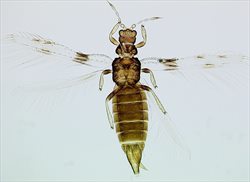
Female

Antenna

Head & thorax
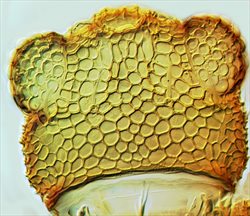
Head
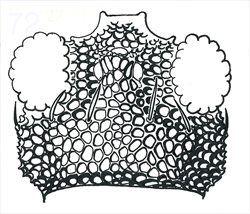
Head
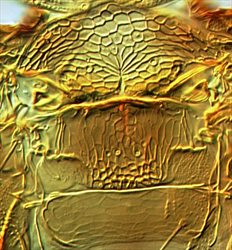
Meso & metanota
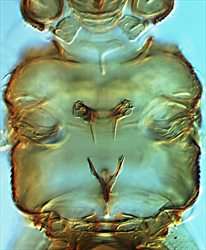
Meso & metathoracic furcae
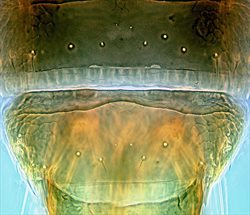
Tergites VII-VIII
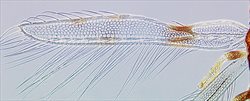
Fore wing

Fore wing
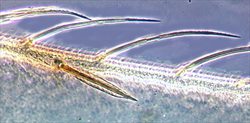
Fore wing costal seta
Both sexes fully winged. Body and femora brown, tibiae and tarsi yellow; antennal segments I–V largely yellow; fore wing mainly pale, but with a small dark cross band in basal half and a diffuse shaded area on the distal half. Antennae 7-segmented, VII slightly shorter than VI; III–IV with short, simple sense cone. Head strongly reticulate, cheeks constricted to basal neck; 3 pairs of translucent postocular setae. Pronotum reticulate, with 1 pair of flattened postero-angular setae. Metanotum reticulate medially, median setae arise on posterior half; metathoracic furca U-shaped but not long. Tarsi 1-segmented. Fore wing broad with constriction in basal third, membrane reticulate; veinal setae translucent, broad with thickened median rhachis; costa without cilia, postero-marginal cilia wavy. Abdominal tergites without craspeda, with weak reticulation laterally, median setae small; VIII with no marginal comb of microtrichia; tergite X with complete median division.
Male similar to female; sternites IV–VII with circular pore plate, larger on posterior sternites.
Known as the Parlour Palm Thrips, this is the only species in the genus Parthenothrips. Within the sub-family Panchaetothripinae, the only other species with expanded fore wings are the Neotropical "peanut winged thrips" in the genus Arachisothrips.
Feeding, breeding, and pupating on the leaves of a wide range of plants, most of which have hard leaves. Frequently associated with the leaves of the cultivated kentia palm or parlour palm (Howea forsteriana) [Palmae], but also commonly found on ferns such as Adiantum spp. [Pteridaceae].
Occasionally found in Britain under glass or on indoor landscape planting (Mound et al., 1976), and similarly elsewhere in Europe (zur Strassen, 2003). The Parlour Palm Thrips is widespread around the world in tropical and subtropical countries, but its country of origin remains a subject for speculation.
THRIPIDAE - PANCHAETOTHRIPINAE
Parthenothrips dracaenae (Heeger)
Heliothrips dracaenae Heeger, 1854: 365
Parthenothrips concolor Uzel, 1895: 172
Mound LA, Morison GD, Pitkin BR & Palmer JM (1976) Thysanoptera. Handbooks for the Identification of British Insects 1 (11): 1–79.
zur Strassen R (2003) Die terebranten Thysanopteren Europas und des Mittelmeer-Gebietes. Die Tierwelt Deutschlands 74: 1–271.